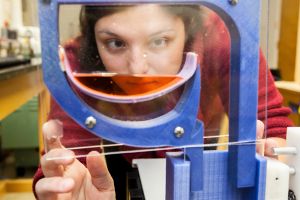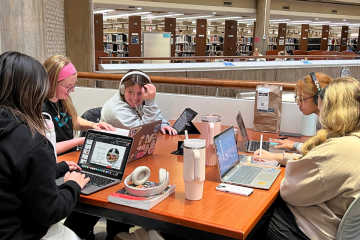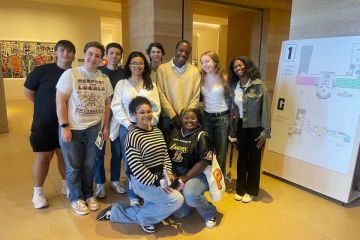Engineering Solutions to Medical Problems

Samantha Eigenbrot took steps to help people with amputated limbs more easily navigate life.
Morgan Butler searched for ways to avert a complication facing Parkinson’s patients.
Shania Shaji tackled research to prevent a prevalent birth-related injury.
All three women – 2018 graduates of Widener’s master’s program in biomedical engineering – have spent their time on campus advancing research addressing major health issues that could potentially improve millions of lives.
“The reason we get into biomedical engineering is to assist where we can, to hope our research can help, or at least be a step in the right direction,” said Butler.
And Widener has helped these graduates find their direction. They credit hands-on research opportunities and close faculty mentorships with putting them on their path to careers in the field.
At Every Turn
A cross-country runner, Eigenbrot understands how the body moves. She put that knowledge to use to help veterans, diabetics, and others with amputated lower limbs better manage their prostheses to avoid falls while turning.
Working with the late Jonathan Akins, professor of biomedical engineering, Eigenbrot visited veterans and physical therapy clinics. There, she attached body sensors to patients to compare steady-state turning (curved path) to transient turning (90-degree). Eigenbrot also conducted studies in a campus laboratory outfitted with floor sensors and video cameras.
“I wanted to see how (people) walk, how fast they’re going, how they’re leaning – all things that could lead to a fall,” said Eigenbrot, who found curved path turns were easier to navigate.
The goal is to provide physical therapists with information to better assist clients.
“I want to make the things that help doctors help people,” said Eigenbrot, now pursuing a doctorate in rehabilitation science. “Widener helped me with hands-on research, internships, and interacting with people.”
Difficult to Swallow
Morgan Butler loves building and taking things apart to see how they work. So to understand swallowing disorders, or dysphagia, she 3-D printed and constructed a mechanical model of the mouth and throat.
People with muscular or neurological disorders, including Parkinson’s, can lose feeling in their throats, and won’t cough up food and liquid particles that, when swallowing, break off and go down the trachea instead of the esophagus. This can lead to pneumonia.
Working with mechanical engineering professor Mark Nicosia, Butler created the model to examine pre-swallow scenarios and liquids with different thicknesses. A common treatment for dysphagia is adding thickening powder to water to prevent particles breaking off.
Butler found higher thickness liquids caused less spillage into the trachea.
“It’s not a cure but advice for doctors, food companies, people who work in assisted living facilities,” said Butler, who credits co-op experiences while at Widener with sparking her interest in the medical device field.
Delivering Results
During delivery, excessive forces on the baby’s nerves running from neck to shoulder can cause neonatal brachial plexus palsy (NBPP), or loss of movement in the arm.
When Shania Shaji learned of the issue – and of biomedical engineering professor Anita Singh’s work aimed at understanding the injury mechanisms that can help develop preventative strategies for NBPP – she joined the effort.
With piglet nerves (anatomically similar to humans), Shaji studied failure forces at two different speeds of stretch, the first research of its kind. The ultimate goal is to provide preventative strategies to clinicians in the delivery room.
“It’s so important if (NBPP) can be prevented,” said Shaji. “I’m incredibly grateful for the opportunity to be a part of this research to assist in the development of preventative strategies.”
Drawn to Widener by close student-faculty interactions, Shaji benefitted from working directly with Singh, a rising leader in this field who has received prestigious grants to advance the research.
Shaji, a recipient of a national award for her work, is now an engineer for a medical device firm.






